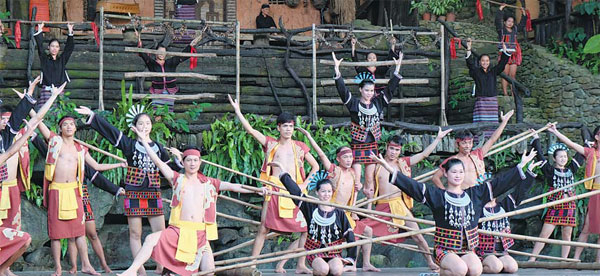Li and Miao heritage adds to Hainan's allure
Ethnic minorities share Their traditional lifestyles with resort's many visitors
The unique cultures and arts of ethnic minorities on the island province of Hainan add to the Chinese beach destination's charm for foreign tourists, especially those from Europe.
Last year, 660,000 inbound overseas tourists visited Hainan island. As well as enjoying the sun, beaches and water sports, they also explored the time-honored customs and arts of the Li and Miao ethnic groups.
|
A traditional bamboo dance of the Li ethnic group. Photos by Huang Yiming / China Daily |
The Li people, the indigenous inhabitants of Hainan island, are proud of their traditions, and the ethnic group's traditional textile techniques were added to the UNESCO list of Intangible Cultural Heritage items in 2009.
Woven of fiber made from the fruit of kapok trees, Li brocade is one of the country's earliest known textiles. It is said that spinner Huang Daopo (1245-1330), known as the mother of Chinese textile technology, learned to weave from the Li people in Hainan and she is said to have improved the loom they used. She later introduced their handiwork to central China.
Besides their textile arts, the Li people have a legacy of other intangible cultural heritage that has been preserved over their more than 3,000-year-long stay on the island, such as making cloth from tree bark and the bamboo dance.
The Miao people are the second-largest ethnic minority group in Hainan. They moved to the island more than 400 years ago. Miao women are good at singing and handiwork, especially cross-stitching exquisite patterns on brocade.
Many scenic spots have been established in Hainan to preserve the cultural gems of the Li and Miao peoples and better display them to tourists from home and abroad.
The Binlang Valley Cultural Tourism Zone features the Li and Miao culture. Built in 1998, the zone was developed from a Li village called Ganshi into a vast scenic area where tourists can visit the homes of Li and Miao people, browse exhibitions of intangible cultural heritage, watch singing and dancing performances and enjoy the cuisines of the two ethnic groups.
Some of the elderly people who lived in the Li village stayed on when it was turned into a scenic spot. They reside in boat-shaped houses, weaving Li brocade and playing traditional musical instruments, still living as their ancestors did and showcasing their traditional culture.
The Binlang Valley scenic spot received more than 980,000 tourists from home and abroad last year. Constant streams of visitors may have brought bustle into the villagers' peaceful life, but the villagers have also benefited from the local government's tourism development.
Su Yingli, a 63-year-old Li woman who lives in the valley, leases her house to the tourism zone for a monthly rent of nearly 2,000 yuan ($312). She still lives in her house, cleaning it each morning before any tourists arrive.
As darkness falls, Su enjoys the tranquility with two good friends who she invited to live with her after her husband passed away four years ago.
The zone was upgraded to a national 5A-level scenic spot earlier this month, becoming the country's first 5A-level scenic spot for folk customs.
A group of Russian painters visited the Binlang valley in March and were captivated by the original culture of the Li people and their mysterious totem art. The Russian artists described the tourism zone as a "natural treasurehouse very suitable for creating art".
To attract more foreign visitors to appreciate Hainan island's natural and cultural beauty, the provincial government provides inbound overseas tourist groups from 26 countries with visa-free entry.
Fourteen European countries are on the list, including Russia, Germany, the United Kingdom, France, Sweden, Italy, the Netherlands, Spain, Switzerland, Austria, Finland, Denmark, Norway and Ukraine.
With the exception of Russia and Germany, tourist groups that consist at least five members from the other European countries on the list are allowed a visa-free stay in Hainan of up to 15 days.
The visa policy is even more relaxed for tourist groups from Russia and Germany. The maximum allowable stay for these nationals is 21 days and groups from the two countries need only include two people to qualify.
In total, 46,522 foreigners visited Hainan on visa-free stays in 2014, mainly from Russia, the Republic of Korea and Kazakhstan.
Contact the writers through xujingxi@chinadaily.com.cn



















